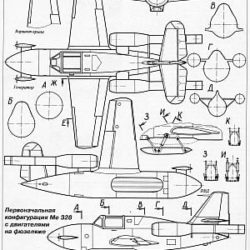Messerschmitt Me 328 History
Although the Messerschmitt Me 328 was never destined to become operational or even technical successful, it is of interest as one of the few piloted aircraft to fly solely on pulse-jet power, and, in view of its early lack of promise, the diversity of design proposals is surprising.
The basic design was first started by Messerschmitt late in 1942 as a cheap and simple high-speed aircraft for low-level bombing and possibly also for the emergency day-fighter role. Also considered by the Messerschmitt engineers was work done the previous year by the DFS, in which various layouts of the Messerschmitt design study P.1078 (which proposed various jet engine installations in a single-seat aircraft) were examined for their possible application as parasite or hook-on components of larger aircraft.
The general layout of the Messerschmitt Me 328, which in overall size was even smaller than the Heinkel He 162, was that of a mid-wing aircraft, the circular-section fuselage having a raised canopy with a rearing fairing extending back and down to the base of the fin. The tailplane was mounted halfway up the fin, and the equi-tapered wing had leading-edge slots and inboard landing flaps. Provision was made to alter the span of the wings, for test purposes, by means of detachable tips and, since the pulse-jet powerplants could provide no auxiliary drives, electrical power was obtained from wings-mounted air-driven generators. Self-sealing fuel tanks were housed in the rear fuselage and in the nose, and the pilot was protected by some armour plate and a bullet-proof windscreen. An extendible skid sufficed for landing gear.
The main criterion guiding the Messerschmitt Me 328 programme was to produce a cheap rapidly-built aircraft in large numbers. After widespread research and development the V1 glider began pick-a-back test with Dornier Do 217 as carrier in autumn 1943. Final construction of the Me 328 was planned to be largely of wood, but, for the first test airframes, various composite constructions methods were tried. Powered tests began with two 660 lb (300 kg) thrust As 014 pulsejets on the rear fuselage, with severe problems. Then tests were made with two ducts under the wings, some being hung as far aft as possible because the intense noise damaged the wooden airframe. The A-1 fighter had two wing ducts and the A-2 four on the fuselage; respective armament was two MG 151 and two MK 103. The work then switched to assault (some expendable) with bomb loads up to 3,087 lb (1400 kg), the B-1 having wings engines and the B-2 bigger ducts of 880 lb (400 kg) each. Takeoff was by rocket trolley, cable winch and other means. Other Messerschmitt Me 328 versions were to be catapulted from U-boats.









